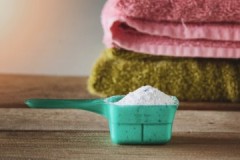Expert advice on where to put powder in your washing machine
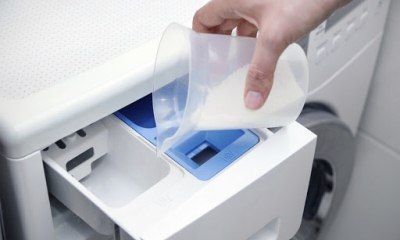 Each manufacturer's manual for the operation of the automatic machine contains information about the rules for loading household chemicals to obtain an effective washing result.
Each manufacturer's manual for the operation of the automatic machine contains information about the rules for loading household chemicals to obtain an effective washing result.
If the documents do not contain a description in Russian, they are lost or a unit that was in use was purchased, tips from professionals and experienced housewives will help to figure out the function of the cells in the tray.
We will tell you about where to put the powder (as well as pour the gel, place capsules, tablets, etc.) into the washing machine in the article.
Content
How is it correct - in which compartment, cell?
All funds are loaded into the tray (cuvette) of the washing machine before starting the program... If the hostess forgot to add some product, it can be added later if the washing phase with its use has not yet begun.
The tray is made of plastic. Its front panel has the color of the case, the inner part is white or gray.
Description of the cells of a typical drawer cuvette:
| Marking | The size | Components | Function | What to download |
| 1, I, A | average | absent | pre-soak, double wash cycle | powder, starching agent (bulk only) |
| 2, II, B | big | curtain | main loop | bulk, liquid detergents, bleaches, stain removers, softeners |
| Softener, *, flower | small | overflow valve | laundry care | conditioner, fabric softener (liquids only) |
The cap with the MAX mark (overflow valve) is not a dispenser, it shows the maximum amount of product that can be poured into the softener compartment.
The shutter (special partition) in the cell for the main cycle is necessary for the transition from liquid detergent (it is lowered before pouring) to bulk (raised) and vice versa.
The number, structure and location of cells for household chemicals may vary from manufacturer to manufacturer.
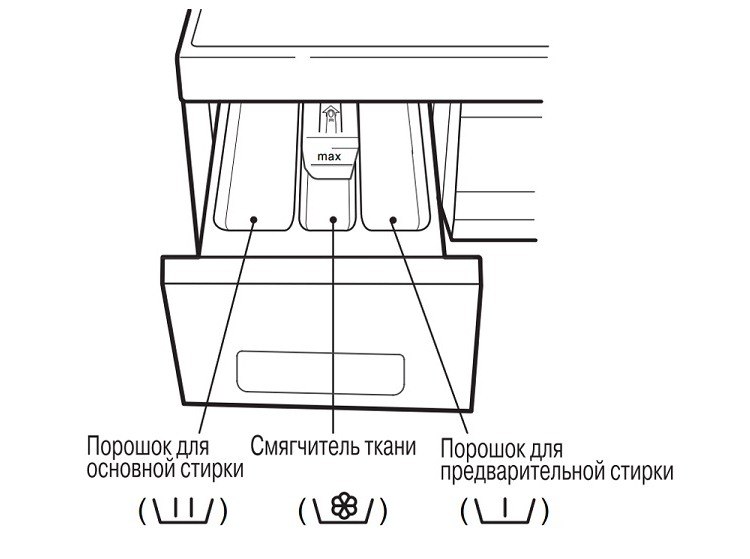
What happens if you upload to the wrong department?
According to manufacturers and service workers, misuse of the tray compartments will not harm the washing machine... If the hostess messes up the cells and the powder gets into, for example, the conditioner cell, only the washing quality will suffer.
The laundry will not only not get rid of dirt in the process, but will also receive a soapy solution when rinsing. This will lead to additional consumption of household chemicals, electricity and water. The unit will have to be loaded again and the wash cycle repeated.
Differences for machines with different loads
A significant difference between washing machines with vertical and horizontal loading is the location of the tray with cells for detergents, bleaching and softening agents.
For top-loading units, the container is located directly in the hatch... The disadvantage of such models: adding a tool after the start of the program will not work, you can temporarily stop it. In modern models, manufacturers have added a reloading function.
Can I pour directly into the drum?
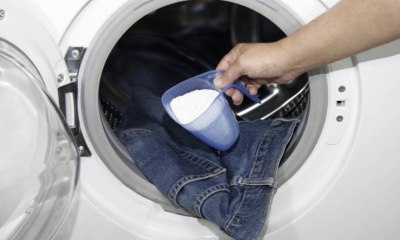 To answer this question, you must refer to the instructions of the manufacturer of the washing machine.
To answer this question, you must refer to the instructions of the manufacturer of the washing machine.
In most cases, this is not recommended., with the exception of some types of household chemicals for washing baby linen.
It is strictly forbidden to put stain removers and bleaches into the drum; they are used only in specially designated cells of the tray.
A granular structure and a more aggressive composition of bulk products are not the best option for proximity to fabrics, mechanical damage and partial loss of their original color are guaranteed.
It is better to pour the powders into a special compartment from which it will be washed, along the transportation route, is dissolved and evenly distributed in the drum.
If the hostess is sure that the bulk product will bring more benefit in the drum, then it is necessary to place it in a special container (a device in the form of a ball with holes), often it comes with a washing machine.
Dosage
Information on the recommended amount of products can be found in the instructions of the manufacturers of household chemicals for washing machines. If it is not possible to study them, there is a proven standard: 1 tbsp. l of powder (25 g) per 1 kg of loaded laundry.
The amount can be doubled if:
- the degree of soiling of the laundry is high, there are old stains;
- the quality of the water is inadequate, it is hard;
- the wash program for certain types of laundry requires more water.
Where should gels, capsules, plates be placed?
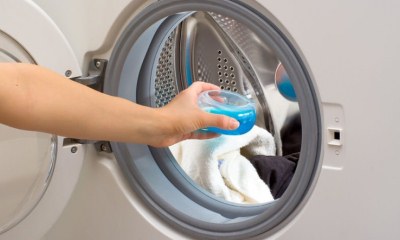 Liquid detergents (gels, concentrates) can be used in several ways:
Liquid detergents (gels, concentrates) can be used in several ways:
- In the compartment marked II, 2, B.
- In the drum of the washing machine.
- Place in a special dispenser and send to the loaded laundry.
Before loading the product into the drum, it is necessary to study the manufacturer's recommendations. On some models this is strictly prohibited.
Direct loading of industrial fluid is undesirable if:
- it contains bleaching particles, direct contact leads to the formation of streaks on the tissues;
- the composition contains components that prevent the formation of scale, in this case they have no effect;
- dry powder is already loaded into the main wash compartment.
Capsules, tablets, plates are more convenient to use, one piece is enough for washing with a load of up to 5 kg. They are placed directly into the drum before starting the unit, the laundry is placed on top. They dissolve quickly and are evenly distributed.
Laundry tablets can also be placed in the main wash compartment... But housewives note that they are most effective in dealing with dirt when loading into the drum.
Differences in the design of trays from different manufacturers
In most cases, the number and arrangement of the compartments for detergents and care products is standard: 3 containers in a pull-out cuvette.
But there are exceptions:
- LG sometimes only offer 2 bays (in older models). The soaking agent (small compartment on the right) and the care agent (insert) are loaded into one compartment.
- The main difference between Indesit is the bleaching agent cuvette, which has a compartment for liquids and bulk or concentrated (thick) products.
- Some models Samsung have an additional compartment in the pre-wash compartment. It is designed to load bleach. If the compartment is not removed, the presoak program cannot be started.
- Most Bosh vending machines have a starch compartment. Starch can only be loaded into the cell as a solution with water.
Cuvette care
A tray for household chemicals in a washing machine is an important part and requires additional care, despite constant contact with detergents.
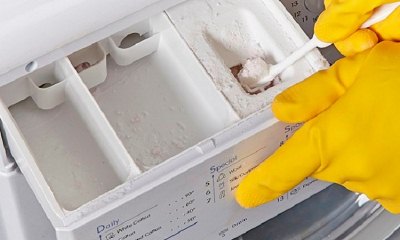 In order for the unit to operate normally, it must be washed and dried to prevent the appearance of:
In order for the unit to operate normally, it must be washed and dried to prevent the appearance of:
- plaque,
- mold,
- clogging of filters and pipes.
In modern front-loading vending machines, the tray is freely removed using a special button (PUSH) or a plastic lever located in the rinsing compartment. If the listed accessories are missing, pull the drawer to pull it out.
Processing recommendations:
- it is necessary to clean after every 3 wash;
- be sure to use a brush or sponge, special household chemicals;
- you can use folk remedies: citric acid, soda, vinegar, its essence.
You will find a lot of useful and important information about washing powder here.
Related videos
How to use the compartments of the washing machine flask correctly, the video will tell you:
Conclusion
Correct loading of household chemicals for washing in the tray of the unit will free the hostess from additional costs and loss of time for a repeated cycle.
To do this, just read the manufacturer's recommendations or use the advice of experts in the production, repair and operation of washing machines.



